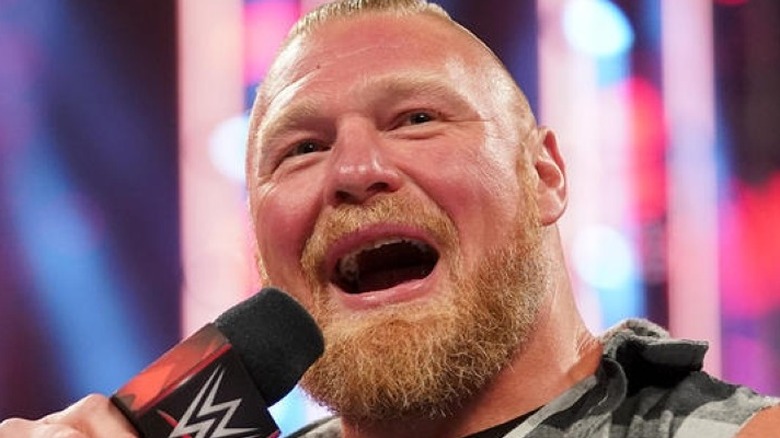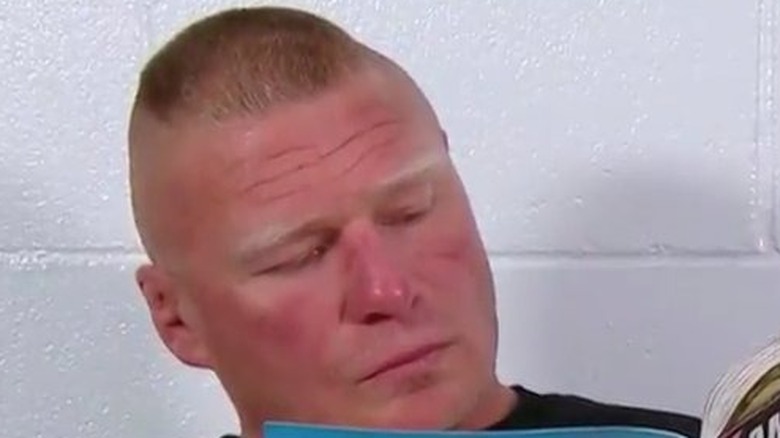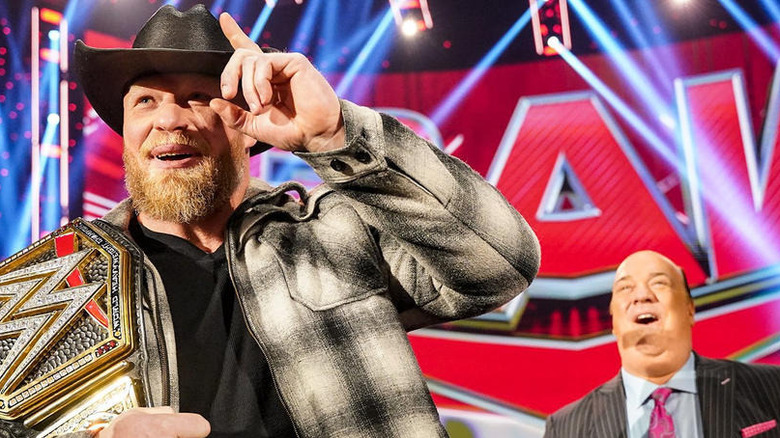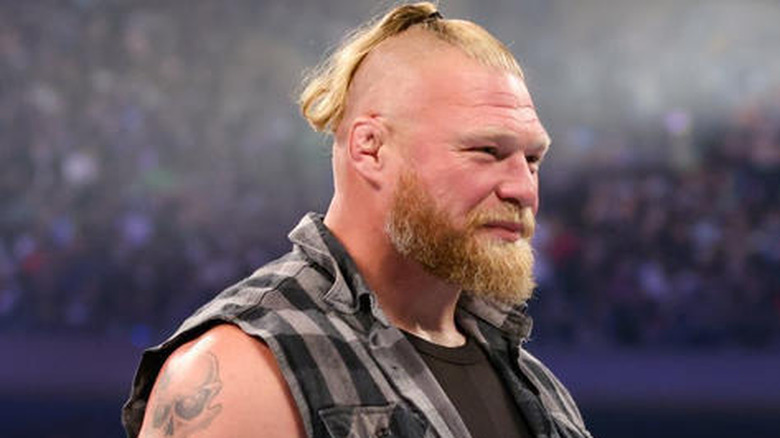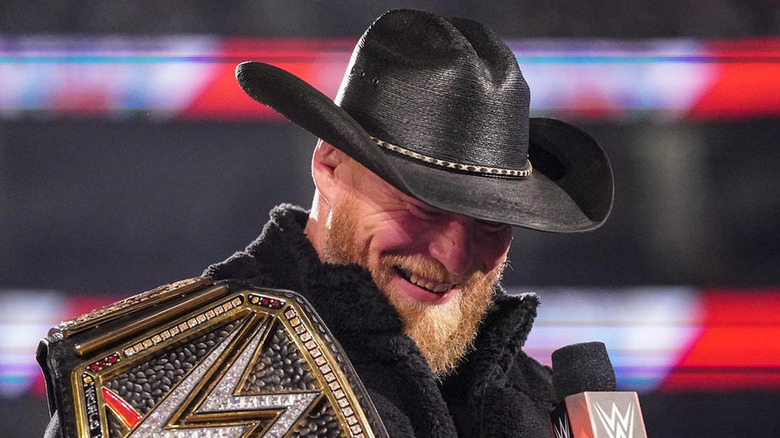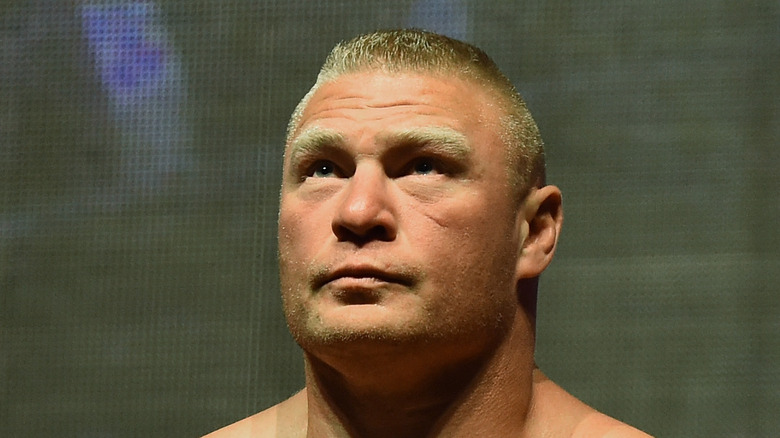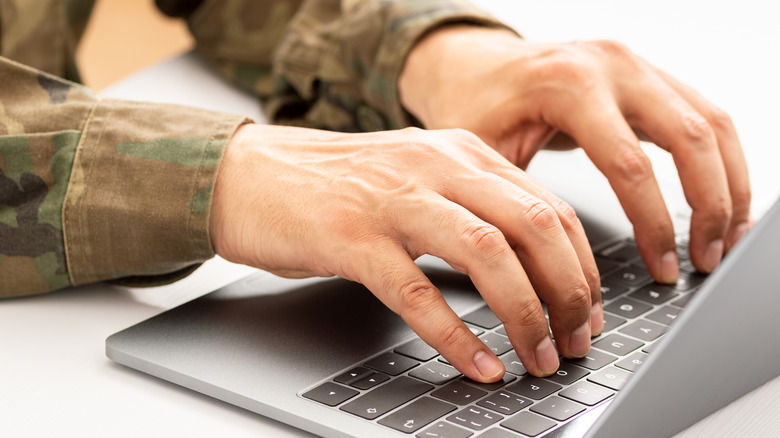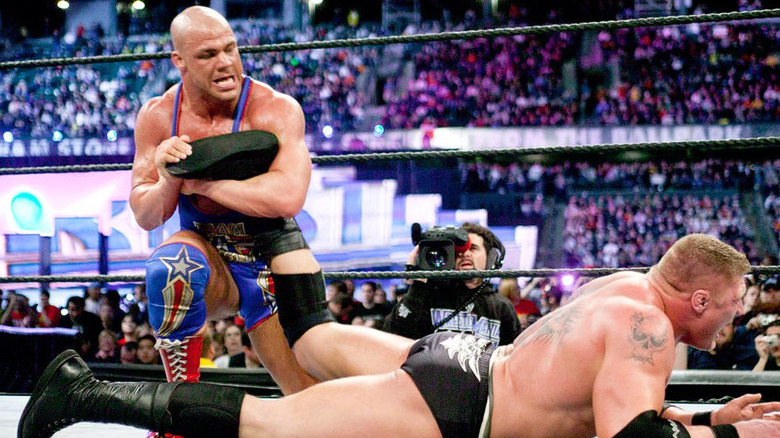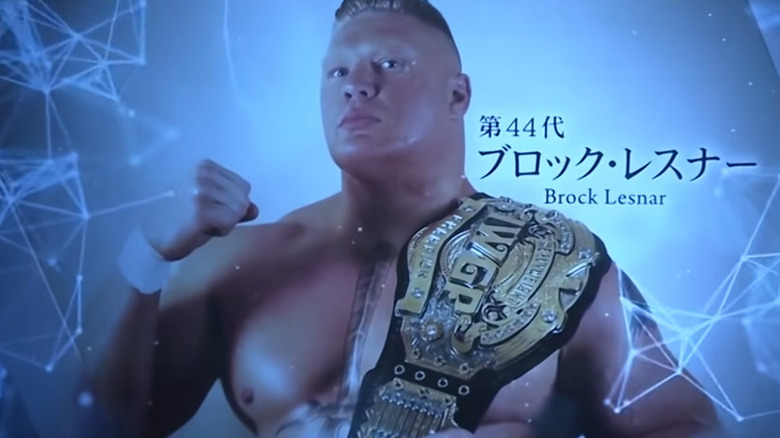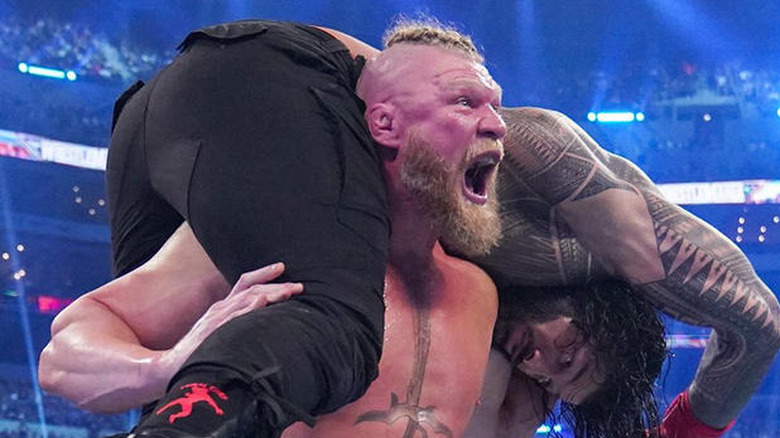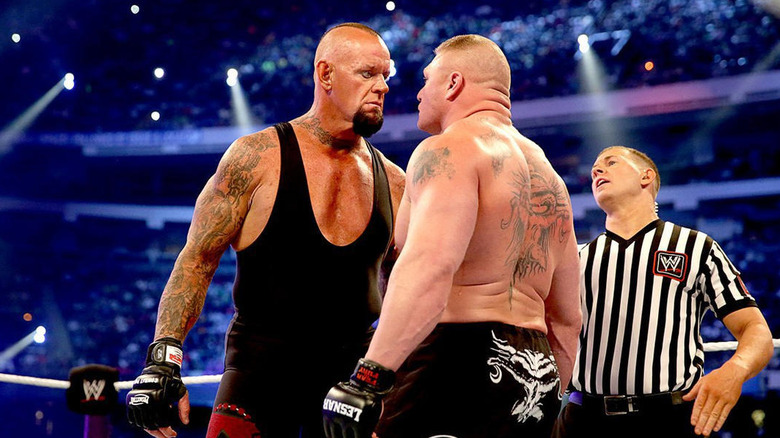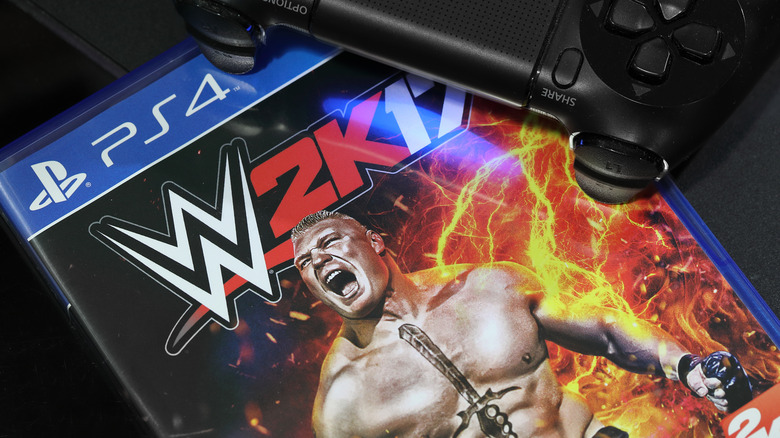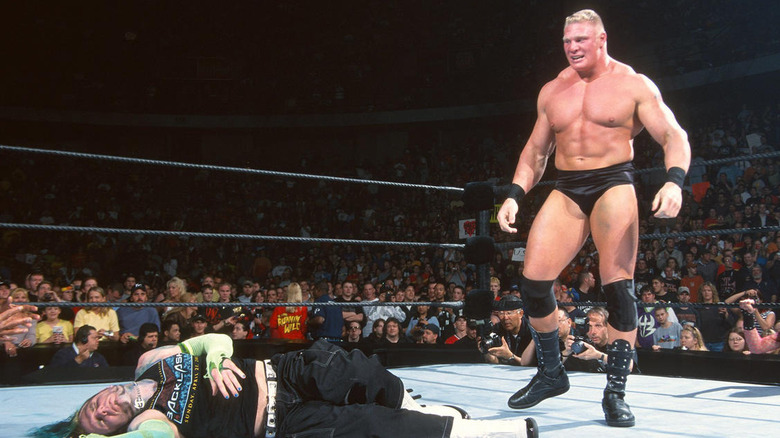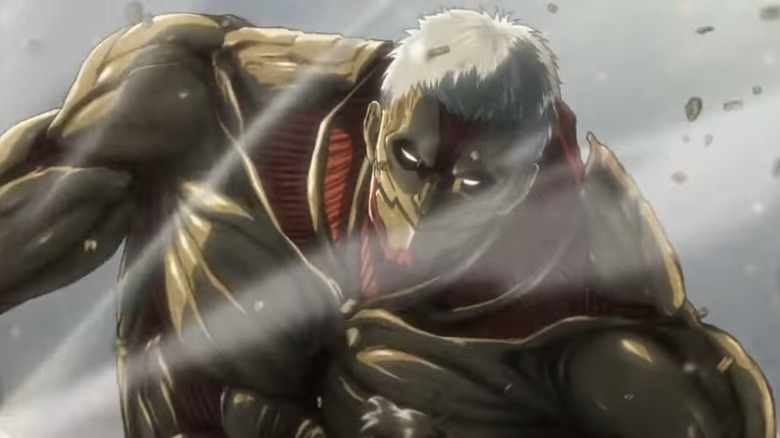Facts About Brock Lesnar Only Hardcore Fans Will Know
We may receive a commission on purchases made from links.
The Next Big Thing. The Beast Incarnate. The One In Twenty One and One. The Mayor of Suplex City.
WWE Superstar Brock Lesnar has had several different nicknames in the 20 years since his official debut, but some things about him have never really changed. He's a true behemoth and instantly recognizable, a monster of a man with a unique sense of style and huge tattoos on his chest and back.
Whether he's coming to the ring in his MMA inspired gear or the straight-off-the-farm flannel and denim look he's been sporting more recently, you know when you hear the opening beats of his entrance song that somebody is going to get hurt. The pyro, that synthesizer, his fighting stance on the entry ramp and his vertical leap from the floor onto the ring apron – these are all parts of his character that Brock has perfected over years in the industry.
Brock's determination and single-minded pursuit of greatness in anything he sets his mind to is easy to track. He has won championships during his time in high school, the NCAA, WWE, New Japan Pro-Wrestling, and Ultimate Fighting Championship. He frequently looked unstoppable on his way to those victories.
WWE fans have been cheering Lesnar for decades, but it's widely known that Brock is a very private individual. Let's dive in and expose some little known facts about the man behind the Beast.
Brock wrote an autobiography with Paul Heyman
Brock Lesnar and Paul Heyman have been close ever since they were introduced — so close that they actually authored a book together, "Death Clutch: My Story of Determination, Domination, and Survival," telling Brock's story in his own words. Released in 2012, it covers his early life through his first run in WWE and part of his UFC career, ending just before Brock's loss to Cain Velasquez at UFC 121.
Known for being an intensely private individual, Lesnar said in a 2011 interview with Sports Illustrated that "maintaining my privacy has to do with respect for myself and my family." His trust of Paul Heyman, a reliable friend and confidant since his early days in WWE developmental, allowed Brock to open up and write "Death Clutch." As Brock said, "I had to have some kind of comfort level, and I think Paul was the guy for me to be able to orchestrate this with."
While he hasn't mentioned it recently, Brock did imply that he would be willing to write a sequel to "Death Clutch" in the aforementioned interview. "There's a lot left to be written about ... whether I do it or not, I have no idea." A second autobiography would definitely be welcomed by fans, as Lesnar has gone on to do some incredible things since the conclusion of his first book, including winning multiple championships and ending the streak of the legendary Undertaker at WrestleMania XXX.
Brock Lesnar and Paul Heyman were introduced by Tazz
During an "Inside the Ropes" live show, Paul Heyman told a story about how Brock Lesnar was being given bad advice by a number of veterans early in his WWE training days. He was told not to sell offense, and to take on the character of a stoic Russian. According to Heyman, WWE and ECW veteran Tazz approached Lesnar and said "they giving you the wrong advice, brotha. You don't wanna do this." Lesnar, despite his inexperience, agreed that it was a bad idea.
A friend of Paul Heyman from their days in ECW, Tazz brought Lesnar to Heyman and relayed the information. Heyman told Brock, "you realize if you do what they're telling you it will ruin you. You'll leave here in six months. Do you want me to talk to Vince about this?" Lesnar agreed and Heyman was paired with him shortly afterward.
While their onscreen partnership has been off and on since Lesnar's debut, with Heyman frequently turning on Brock to temporarily support other "Heyman guys" such as CM Punk and Roman Reigns, Paulie always seems to end up back by The Beast's side.
Farmer Brock isn't just a wrestling character
Lesnar grew up poor on a dairy farm in Webster, South Dakota, a small town known mostly for hunting, fishing, and being the hometown of Brock Lesnar.
Brock has told stories of the farm nearly going into foreclosure. "We couldn't pay our bills" he told ESPN. "I can remember going to town to get a load of grain, and the elevator not letting me have any." Lesnar knew there were bigger things for him than that farm, and he worked towards getting out of the small town life.
In high school, Brock was able to use the strength and size he built up working on the farm to become a football player and wrestler. He won a junior college championship in 1998, and went on to win the NCAA championship for the University of Minnesota two years later. He was recruited by WWE shortly thereafter, even though he had "never watched a lick of wrestling ... but then they slapped a lot of money on the table, a quarter million dollars." Pro wrestling, something Brock said wasn't real before he got involved in the business, was his ticket out of South Dakota.
These days, Brock has a farm of his own - and he's a grandpa
Craving a return to his country life, Lesnar said in his book that he's moved onto a farm of his own in Maryfield, Saskatchewan, where he lives with his wife, Rena (former WWE star Sable), and their younger children. Brock also has two older kids from a previous marriage. He's stepfather to Rena's daughter from her first marriage, who has a child of her own, making Brock Lesnar a step-grandfather.
Located about 150 miles outside of Regina, the farm is a refuge for the Beast Incarnate. Lesnar and his family have had the property since Brock's first departure from the UFC back in 2011. While Regina itself is a larger city, boasting a population of around 200,000, the village of Maryfield is definitely more Brock's speed — only 311 residents call it their home.
Brock has mentioned how important his farm is to him in several interviews, and how it's necessary for his mental health to go back and recharge after performing in front of thousands for the WWE. "I have a total crash after being in front of audiences," he told Pat McAfee. "Like, I go hibernate in Saskatchewan."
For their part, Saskatchewan has welcomed Brock publicly. When Lesnar chose to represent Maryfield for his match against Mark Hunt in 2016, Brad Wall, then the premier of Saskatchewan, broke the news on Twitter, saying, "All the best at #UFC200 my friend."
The Beast has dealt with some serious trauma
In a segment on ESPN, a childhood friend of Lesnar's remembered asking Brock why he got his massive chest tattoo. Lesnar replied, "it felt like I always had a knife at my throat." He has discussed dealing with physical injuries and emotional trauma in interviews and in his book, mentioning a dependence on pills and alcohol early on in his WWE career. He's also dealt with anxiety stemming from his introverted personality and having to be "on" in the WWE setting. He told Pat McAfee "I'm in front of an audience then it just exhausts me." In the aforementioned ESPN interview, Lesnar said, "There's like two years, I don't remember my life ... vodka and pain pills, that's why I don't remember it. I was in a lot of pain, mentally and physically."
On top of the emotional stress that comes from a very private man in the very public business of professional wrestling, Lesnar has dealt with a number of brutal physical injuries as well. He mentioned wrestling "with my MCL blown out and three broken ribs, and I wrestled that way for six months because I had just become the champion," as well as performing with knee, back, and neck issues. Brock's position as a relative newcomer to wrestling and a new champion pushed him to work through those injuries. In his book, Brock mentions the infamous missed Shooting Star Press in his match with Kurt Angle at WrestleMania XIX as the source of major neck pain.
If you or anyone you know is struggling with addiction issues, help is available. Visit the Substance Abuse and Mental Health Services Administration website or contact SAMHSA's National Helpline at 1-800-662-HELP (4357).
If Brock Lesnar could type, we may have never known him
Brock Lesnar joined the Army National Guard when he was seventeen years old, hoping to work with explosives. "Joining the National Guard changed my life," Brock said in an interview with Flex. Lesnar credited the Guard with teaching him respect, saying that the Guard "straightened my a** out right away."
For nine weeks, Lesnar was assigned to an artillery supply unit at Fort Leonard Wood in Missouri. Per Lesnar's book, the boxes were sorted by color, and Brock was born red-green colorblind. A genetic mutation, red-green colorblindness is estimated to affect around one in 12 men worldwide. The result was that Lesnar was unable to safely pursue that career path. He was instead offered a position doing desk duty. He wasn't able to follow through with that, either. After failing a standardized typing test, Brock was discharged.
The thought of a young, furious Brock Lesnar failing a typing test and reacting by heaving a computer tower through a wall, while probably not the truth, is exceedingly funny.
Kurt Angle and Brock Lesnar had an amateur wrestling match in a WWE ring
In a 2017 interview with RF Video, Kurt Angle talked about beating Lesnar in a "shoot" wrestling match. Angle, who went out of his way to mention that "Brock doesn't deserve" to have this story shared, said that when they first met Kurt thought Lesnar was arrogant and "a jerk." Brock was asked how he would do against Angle in a real wrestling match, Kurt says that Lesnar replied "I'd kill him! He's too small." Angle says he confronted Brock about that statement. "Brock said 'come on, Kurt, you're like what, 215? I'm 315.' I said I don't have a problem, let's get in the ring." Brock said he didn't have wrestling shoes, and that was that for a while.
Later that year, in Fargo, North Dakota, Brock and Big Show were having a friendly wrestling match in the ring. As relayed on "Talk is Jericho," Angle watched Lesnar toss Big Show around, then Kurt asked Show to leave while Brock was faced the other way. Show agreed, Angle challenged Lesnar, and "I said 'let's go' and all the wrestlers [surrounded] the ring, lumberjack style." Angle won the match by avoiding takedowns, getting one of his own, and eventually winning by points. The match went about 15 minutes, per Angle.
Angle did make a point to mention Brock's incredible power and speed in that match, as well as the fact that then WWE Head of Talent Relations Jim Ross got into a little trouble for allowing the two to have a "real match" in a WWE ring. Angle mentions his experience, positioning, and training gave him the advantage over Lesnar, even though Lesnar had Angle beat in size, speed, and strength. Angle knew he could defeat Brock long before going into their impromptu match. "You're talking about an NCAA champion and an Olympic gold medalist ... there are two different levels," Kurt said.
Brock Lesnar is one of only a few Americans to hold the IWGP Heavyweight Championship
After Lesnar left WWE after his infamous WrestleMania XX match with Goldberg, he tried to get into the NFL. Although he had a decent training camp with the Minnesota Vikings, Brock didn't make the team and was left looking for a paycheck. "I couldn't figure out which way to turn, and then my lawyer, David Olsen, called me with some interesting news," Brock said in his book (via Pro Wrestling Stories). Olsen had been in contact with New Japan Pro-Wrestling.
Despite it being only his first match in Japan, Lesnar was allowed to main event the historic Tokyo Dome based on his performances with WWE. However, Brock had signed a contract with a long non-compete clause. Lesnar chose to sign with New Japan anyway. Legal actions were taken by WWE, because, as WWE's Bruce Prichard said on his podcast (h/t Post Wrestling), "we had made the investment in him in the sports-entertainment category and wanted to protect that[.] " None of Brock's three championship defenses were postponed because of those legal issues, and WWE and Lesnar did eventually come to an agreement.
Lesnar defeated Masahiro Chono and Kazuyuki Fujita on October 8, 2005, on the New Japan Pro Wrestling pay per view Toukon Souzou New Chapter - winning the IWGP World Heavyweight Championship in his first appearance with the promotion. Big Van Vader, Masahiro Chono, Scott Norton, Bob Sapp, Brock Lesnar, and AJ Styles are the only American born performers to ever hold NJPW's IWGP World Heavyweight Championship, which was retired in 2021.
The F-5 had a sarcastic rebrand while Brock wrestled in Japan
During Brock's time in New Japan Pro-Wrestling, he never shied away from antagonizing Vince McMahon or WWE. Lesnar spoke about his time in Japan in his book (per Pro Wrestling Stories), going into detail about his rivalry with Shinsuke Nakamura, then a 23-year-old up-and-coming shoot fighter known as "the Supernova".
Brock was recruited by New Japan's Antonio Inoki before Inoki broke off from NJPW to form his own rival promotion. Inoki had developed an interesting outlook on pro wrestling, and unsuccessfully tried to blur the lines between wrestling and fighting. He matched Brock with his own chosen hero in Nakamura, and on January 4, 2006, the two had a rough match dominated by Lesnar.
Brock finished Nakamura with his familiar WWE finisher, the F-5. The well known move has been Lesnar's finishing move for years, although after the match Lesnar let it be known that the move would now be rebranded with a jab at WWE's attempts to legally restrain The Beast. As Brock said in "Death Clutch," "In WWE, it was called the F-5. In New Japan, it was called 'The Verdict' ... that was my way of sending a message to Vince and his geek squad lawyers."
The Undertaker had doubts about Lesnar defeating his WrestleMania streak
The Undertaker is a legendary figure in professional wrestling. During his 30 year career, Undertaker went from an undead cowboy mortician to a cult leader to an American Badass and back around to a combination of all of the above, earning the love and respect of WWE fans and management. He did what he thought was best for the business, for his character, and for the other wrestlers he worked with.
When it came time for Undertaker to face Brock Lesnar at WrestleMania XXX in New Orleans, he and Mr. McMahon were indecisive on whether Taker would be extending his streak to 22-0. In an interview with CBS Sports, Undertaker said, "We had gone back and forth depending on the day." Undertaker says he learned that he would be taking the loss at 1pm on the day of the biggest wrestling show of the year.
When asked if he had any regrets, Undertaker said no. But he did follow that up by saying, "there might have been someone down the line that could have benefitted from it more and that probably would've been Roman (Reigns) later on." To the shock of thousands in attendance and millions watching around the world, Lesnar pinned the Dead Man.
Lesnar has appeared in over a dozen video games, some not even in a wrestling ring
Brock Lesnar was included on the cover of the PlayStation 2 game "WWE SmackDown: Shut Your Mouth" only seven months after his WWE main roster debut. Lesnar has been the featured superstar on only two other WWE-branded video games released since then: "WWE SmackDown: Here Comes The Pain" on the PS2 in 2003, and "WWE 2K17", released on multiple platforms in 2016.
Lesnar was part of the roster of four WWE releases before he left wrestling for the NFL and MMA. "WWE '13" was his first roster appearance in a major console game after his return, and he's been a part of every 2K branded WWE game since and a number of other mobile games so far.
Some weird highlights include "WWE Crush Hour," a car combat game for PS2 and GameCube from 2003 similar to "Twisted Metal," in which Brock drove an armored car, and "Apptivity WWE Rumblers" in 2012, an iOS toys-to-life game that was Brock's first game appearance after rejoining the WWE roster in April of 2012.
Additionally, Brock was included in a few non-WWE games during his time away from the company. He appeared in EA's "Madden NFL 06," Yuke's "Wrestle Kingdom," and five UFC games, including THQ's "UFC Undisputed 2010" where he was featured as the cover athlete.
Brock Lesnar won his first professional bouts in pro wrestling and MMA
Dedicated to being the best in anything he puts his mind to, Brock Lesnar had success in high school football and NCAA wrestling before he ever stepped foot in a WWE ring. When he was recruited by Vince McMahon, the CEO of WWE had no intention of letting that kind of momentum go to waste. Lesnar defeated veteran grappler Jeff Hardy in his first televised match on WWE Raw on April 21, 2002. It wasn't a competitive match, either. Lesnar tossed Hardy around the ring with ease, and won by way of a knockout — a finish rarely seen on WWE programming.
When Brock made the decision to change careers again, first to the NFL and then Mixed Martial Arts, he had a tougher road ahead of him. His NFL tryouts went well, and he made the practice squad for the Minnesota Vikings, but he was dealing with injuries from a recent motorcycle accident that hampered his overall performance. After he didn't make the team, Lesnar decided to try his hand at mixed martial arts.
Brock won his first and only match with Hero's, an offshoot of K-1 Kickboxing. He fought Kim Min-soo, a kickboxer turned MMA fighter, and it went about the same as Lesnar's WWE debut did. Brock won at 1:09 of the first round by technical knockout, mounting Min-soo and laying a devastating assault of punches until the referee ended the contest.
A character from Attack on Titan was based on Brock's mountainous physique
Brock Lesnar cuts an imposing figure; he's a mountain of tattoos, muscle, and unique hair choices. It's no surprise, then, that several artists have used wrestling's hulking performers as inspiration for their most terrifying villains and giant heroes. Anime and professional wrestling have had a long relationship, with pro wrestling moves and stories being featured in a number of features. In a post on his personal blog, author and illustrator Hajime Isayama showed off some 2013 concept art and mentioned that "Brock Lesnar is the model" for an "armor giant" he was working on at the time.
The art was for Hajime's popular "Attack on Titan," a manga that tells the story of a society overrun by giant "Titans" and the group of hunters dedicated to eradicating them. The giant inspired by Brock became the "Armored Titan" featured in the series. Seems like a perfect fit for the Beast Incarnate.
